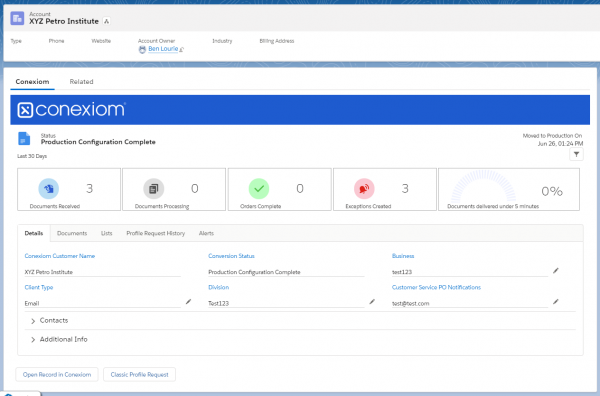Blog Post
You invested in Salesforce® to bring your company and customers together.
To give all employees a 360-degree customer view so they can deliver exceptional customer experiences.
But are you truly optimizing your Salesforce investment if more than 50% of your sales orders live outside the platform?
Probably not.
Executive Vice President of Product Management Ricardo Craft and Executive Vice President of Business Development Erik Severinghaus recently discussed how to optimize your Salesforce instance by automating the orders that are emailed to your CSRs and manually processed.
(Spoiler: There’s an app for that.)
Manual Order Processing Holds You Back from Delivering Top-Notch Customer Service
How relatable are these statements to your business?
- You invested in Salesforce as your customer-relationship management (CRM) tool, but most of your orders live outside of the platform.
- You launched a user-friendly ecommerce website only to discover that customers do not use it to place orders.
- You see CSRs spend up to 50% of their workday manually re-keying and reviewing emailed purchase orders.
You’re not alone. Many manufacturers and distributors are in this situation.
In fact, less than 20% of B2B orders are submitted in a digital format. Most come through email, which is often easiest on the buyer’s end, but overwhelmingly manual for manufacturers and distributors.
Craft succinctly explained the problem:
“If I’m going to buy from a manufacturer or distributor, I need to go into my ERP and create a purchase order. I click the ‘Send via email’ button, and that email goes to the vendor. At that point, a CSR opens the email, opens the attached PDF, and manually inserts that order into an ERP system on his end. And 50% of all B2B orders are painstakingly processed like that.”
There is a way to eliminate this repetitive, tedious task: turn these emailed orders into digital orders.
A Digital Order by Any Means Would Be Just as Sweet
A digital order is any order that is processed through a digital channel with little to no manual entry, such as an EDI, ecommerce, or automated order.
A digital order is comprised of a few different ordering methods:
- Ecommerce website, where customers transact directly into your ecommerce system.
- Electronic data interchange (EDI) implementations, which allows two companies to connect through a specific integration.
- Customer portals and punch out catalogs.
- Automating orders that come in manually, such as through email or fax. (Conexiom lives here.)
The last point, automating orders submitted through email, is the ultimate goal of order digitalization, because according to our research, about 50% of customers still purchase via email. Email still proves to be the simplest path to ordering, despite other options.
By automating those orders, not only do you eliminate all the manual-entry work that CSRs perform on a daily basis, you create operational efficiencies with the benefit of being able to track those orders within Salesforce.
Digital Orders Significantly Impact Business, in a Good Way
Digital orders:
- Drive revenue growth, especially because CSRs are focused on customers, not manual data entry.
- Deliver a seamless customer experience, making it easy for customers to do business with you. And keep doing business with you.
- Improve process efficiencies, because orders are processed faster and with better accuracy.
The EBITDA Upside of Going Digital
As an example, we recently read a financial report from a large distributor that showed a 2x increase in EBITDA as the percentage of digital orders in their business increased from 15 to 45%. That’s right. Just by digitizing the manual process of entering emailed orders, the C-suite can give back to stakeholders or reinvest in the business.
Automating sales orders not only frees up staff to focus on customers, but it also offers significant business and financial benefits.
How do you digitize orders that come in through email and bog down your CSRs’ productivity?
Digitize Emailed Orders with Conexiom for Salesforce
As the market leader in Sales Order Automation Software, Conexiom solves this problem by taking emailed orders and converting them into touchless, digital orders via a composite app called Conexiom for Salesforce (available on the AppExchange).
With this app, Salesforce becomes a centralized management hub for orders, giving CSRs access to the Conexiom Partner Portal directly within Salesforce. It also improves the ROI related to your investment by providing more customer-engagement data within Salesforce and serving as a single pane of glass for digital orders that were historically manually entered into the backend ERP system.

With Conexiom and Salesforce, you can:
- Gain visibility into documents processing automatically with Conexiom from within SFDC
- Track and monitor alerts to ensure orders are placed quickly and accurately
- Manage exception handling and case management
- Analyze account-related KPIs via Conexiom reports and dashboards
This integration allows you to maximize your Salesforce investment while achieving a significant percentage of touchless digital orders with Salesforce.
Conexiom’s SaaS automation platform eliminates manual entry and approvals in the order-fulfillment process by transforming complex unstructured data into 100% accurate touchless documents.
According to Severinghaus,
“(This app) drives a key metric for many, which is achieving a certain percentage of digital orders. This integration immediately shifts those 50% of manually processed orders into digital orders, and that can be transformative for many businesses.”
To get started with the Conexiom for Salesforce app, reach out to your customer-success or account manager.
Watch the on-demand webinar, which includes a visual demo of the app Conexiom for Salesforce. Also available on the AppExchange: Conexiom for B2B Commerce.
“The power of Conexiom and B2B commerce enables Nexeo Plastics’ customers to buy the way they want to buy, provide complete order and customer visibility in Salesforce.com, and further advance our goal of touchless B2B orders.”
Larry Hunt
Vice President of Customer Solutions
Nexeo Solutions
